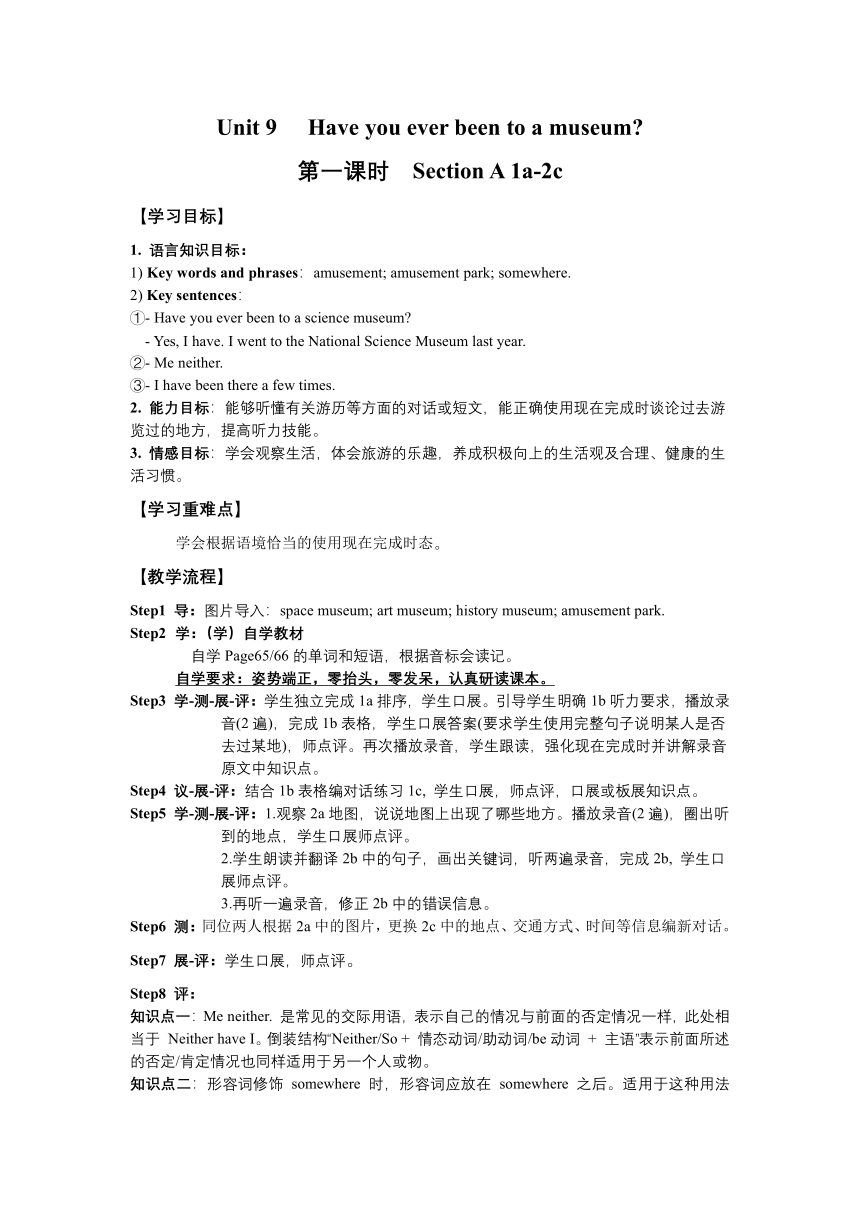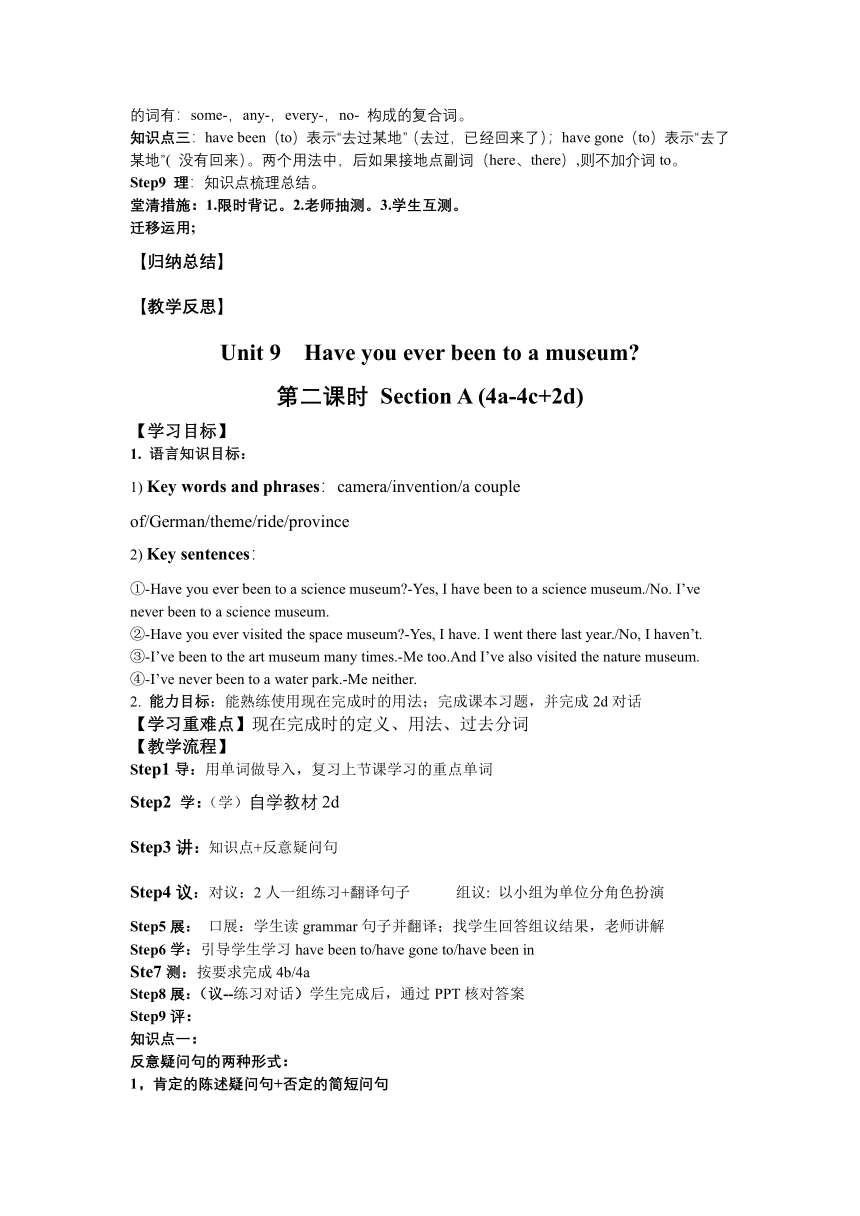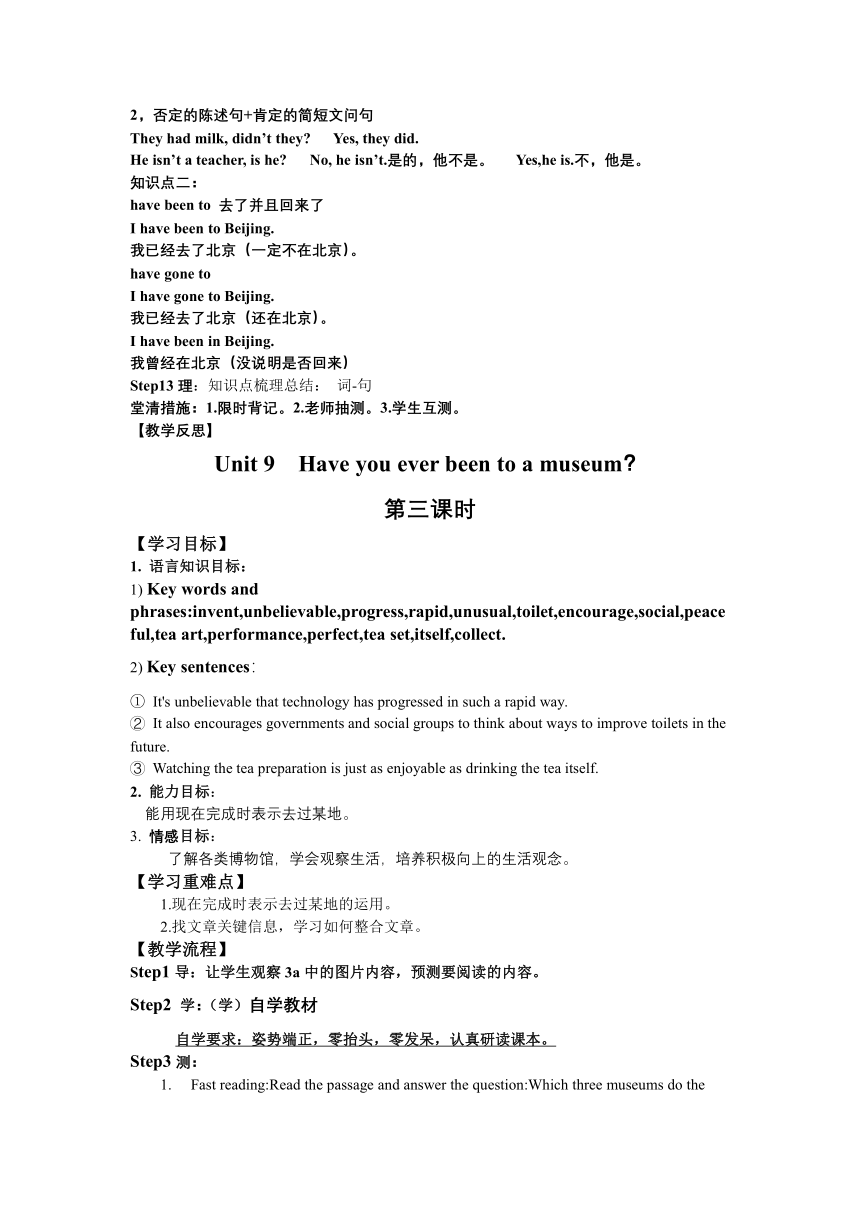人教新目标(Go for it)版八年级下册 Unit 9 Have you ever been to a museum?单元教案
文档属性
| 名称 | 人教新目标(Go for it)版八年级下册 Unit 9 Have you ever been to a museum?单元教案 |  | |
| 格式 | docx | ||
| 文件大小 | 30.3KB | ||
| 资源类型 | 教案 | ||
| 版本资源 | 人教新目标(Go for it)版 | ||
| 科目 | 英语 | ||
| 更新时间 | 2023-05-20 00:22:54 | ||
图片预览



文档简介
Unit 9 Have you ever been to a museum
第一课时 Section A 1a-2c
【学习目标】
1. 语言知识目标:
1) Key words and phrases:amusement; amusement park; somewhere.
2) Key sentences:
①- Have you ever been to a science museum
- Yes, I have. I went to the National Science Museum last year.
②- Me neither.
③- I have been there a few times.
2. 能力目标:能够听懂有关游历等方面的对话或短文,能正确使用现在完成时谈论过去游览过的地方,提高听力技能。
3. 情感目标:学会观察生活,体会旅游的乐趣,养成积极向上的生活观及合理、健康的生活习惯。
【学习重难点】
学会根据语境恰当的使用现在完成时态。
【教学流程】
Step1 导:图片导入:space museum; art museum; history museum; amusement park.
Step2 学:(学)自学教材
自学Page65/66的单词和短语,根据音标会读记。
自学要求:姿势端正,零抬头,零发呆,认真研读课本。
Step3 学-测-展-评:学生独立完成1a排序,学生口展。引导学生明确1b听力要求,播放录音(2遍),完成1b表格,学生口展答案(要求学生使用完整句子说明某人是否去过某地),师点评。再次播放录音,学生跟读,强化现在完成时并讲解录音原文中知识点。
Step4 议-展-评:结合1b表格编对话练习1c, 学生口展,师点评,口展或板展知识点。
Step5 学-测-展-评:1.观察2a地图,说说地图上出现了哪些地方。播放录音(2遍),圈出听到的地点,学生口展师点评。
2.学生朗读并翻译2b中的句子,画出关键词,听两遍录音,完成2b, 学生口展师点评。
3.再听一遍录音,修正2b中的错误信息。
Step6 测:同位两人根据2a中的图片,更换2c中的地点、交通方式、时间等信息编新对话。
Step7 展-评:学生口展,师点评。
Step8 评:
知识点一:Me neither. 是常见的交际用语,表示自己的情况与前面的否定情况一样,此处相当于 Neither have I。倒装结构“Neither/So + 情态动词/助动词/be动词 + 主语”表示前面所述的否定/肯定情况也同样适用于另一个人或物。
知识点二:形容词修饰 somewhere 时,形容词应放在 somewhere 之后。适用于这种用法的词有:some-,any-,every-,no- 构成的复合词。
知识点三:have been(to)表示“去过某地”(去过,已经回来了);have gone(to)表示“去了某地”( 没有回来)。两个用法中,后如果接地点副词(here、there),则不加介词to。
Step9 理:知识点梳理总结。
堂清措施:1.限时背记。2.老师抽测。3.学生互测。
迁移运用;
【归纳总结】
【教学反思】
Unit 9 Have you ever been to a museum
第二课时 Section A (4a-4c+2d)
【学习目标】
1. 语言知识目标:
1) Key words and phrases:camera/invention/a couple of/German/theme/ride/province
2) Key sentences:
①-Have you ever been to a science museum -Yes, I have been to a science museum./No. I’ve never been to a science museum.
②-Have you ever visited the space museum -Yes, I have. I went there last year./No, I haven’t.
③-I’ve been to the art museum many times.-Me too.And I’ve also visited the nature museum.
④-I’ve never been to a water park.-Me neither.
能力目标:能熟练使用现在完成时的用法;完成课本习题,并完成2d对话
【学习重难点】现在完成时的定义、用法、过去分词
【教学流程】
Step1导:用单词做导入,复习上节课学习的重点单词
Step2 学:(学)自学教材2d
Step3讲:知识点+反意疑问句
Step4议:对议:2人一组练习+翻译句子 组议: 以小组为单位分角色扮演
Step5展: 口展:学生读grammar句子并翻译;找学生回答组议结果,老师讲解
Step6学:引导学生学习have been to/have gone to/have been in
Ste7测:按要求完成4b/4a
Step8展:(议--练习对话)学生完成后,通过PPT核对答案
Step9评:
知识点一:
反意疑问句的两种形式:
肯定的陈述疑问句+否定的简短问句
否定的陈述句+肯定的简短文问句
They had milk, didn’t they Yes, they did.
He isn’t a teacher, is he No, he isn’t.是的,他不是。 Yes,he is.不,他是。
知识点二:
have been to 去了并且回来了
I have been to Beijing.
我已经去了北京(一定不在北京)。
have gone to
I have gone to Beijing.
我已经去了北京(还在北京)。
I have been in Beijing.
我曾经在北京(没说明是否回来)
Step13理:知识点梳理总结: 词-句
堂清措施:1.限时背记。2.老师抽测。3.学生互测。
【教学反思】
Unit 9 Have you ever been to a museum?
第三课时
【学习目标】
1. 语言知识目标:
1) Key words and phrases:invent,unbelievable,progress,rapid,unusual,toilet,encourage,social,peaceful,tea art,performance,perfect,tea set,itself,collect.
2) Key sentences:
① It's unbelievable that technology has progressed in such a rapid way.
② It also encourages governments and social groups to think about ways to improve toilets in the future.
③ Watching the tea preparation is just as enjoyable as drinking the tea itself.
2. 能力目标:
能用现在完成时表示去过某地。
情感目标:
了解各类博物馆,学会观察生活,培养积极向上的生活观念。
【学习重难点】
1.现在完成时表示去过某地的运用。
2.找文章关键信息,学习如何整合文章。
【教学流程】
Step1导:让学生观察3a中的图片内容,预测要阅读的内容。
Step2 学:(学)自学教材
自学要求:姿势端正,零抬头,零发呆,认真研读课本。
Step3测:
Fast reading:Read the passage and answer the question:Which three museums do the students talk about
Careful reading:Read passage and answer the question:①What do you think is the most interesting thing about each museum ②Complete 3b和3c
Step4议:对议:同位俩人边读边翻译;提问(一英一汉)
Step5展: 口展: 学生展示对议的内容,教师做补充。 教师板展:板书重要知识点。
Step6评:
知识点一:wonder作为动词意为“想知道”后可跟从句,也可作名词,意为“奇观”。
知识点二:rapid指快速的增长,变化等,quick强调时间快速,fast强调速度快。
知识点三:encourage ssb to do sth意为“鼓励某人做某事”。encourage sb in...表示在某方面帮助某人。
Step7理:知识点梳理总结: 词-句
堂清措施:1.限时背记。2.老师抽测。3.学生互测。
迁移运用;
【归纳总结】
1.学生总结 2.老师做重要补充
【教学反思】
Unit 9 Have you ever been to a museum
第四课时 SectionB 1a-1d Self Check
学习目标:
语言知识目标
Key words and phrases:the Terracotta Army; the Bird's Nest; the Palace Museum; have been in.
Key sentences:①—How long have you been in China
—I've been here for two weeks, but I'm going back to Australia tomorrow.
②—Have you traveled much
—Yes, I have. I have seen many interesting things.
能力目标:能听懂有关游历方面的对话或短文
教学重难点: 能正确使用现在完成时谈论曾经游览过的地方
教学流程:
Step1.导:谈话导入
和学生自由交谈,询问他们去过的中国的名胜古迹,引入话题。
Step2.学:出示新单词,让学生根据音标进行拼读,让学生读重点句型。
自学教材,要求学生:姿势端正,零抬头,零 发呆,认真研读课本。
Step3.测:1.学生观察1a图片,把图片和相关英语名称配对,为听力做好词汇铺垫。让学生和同桌就1a的图片,进行简单的对话训练。
A: Have you been to ...
B: Yes, I have. / No, I haven't.
2.让学生先阅读1b,然后再播放录音,学生完成1b活动。教师还可要求学生选出听力中谈到的问题之后记下问题的答案。(口展)
3.第二次播放录音,让学生边听边填写1c的分类信息。注意写关键词(板展)
Step4.议:学生根据1c所填写的内容,复述Peter旅游的情况。先让学生在小组中复述,然后请学生在全班展示。
Step5.展:学生分小组讨论:询问他人旅游的具体情况时,可以问哪些问题 每个小组分享两个句子,写在黑板上。学生就黑板上提出的问题和同桌进行问答。
Step6.评:self check 1.思考以下事情,写出答案
self check 2.完成对话
self check 3.调查报告
Step7理:知识点梳理总结:重点词汇、句型
堂清措施:①限时记忆②教师提问③学生互测。
教学反思:
Unit 9 Have you ever been to a museum
第 五 课时 SectionB 2a-2e
【学习目标】
1. 语言知识目标:
1) Key words and phrases:thousand, safe, simply, fear, whether, Indian, Japanese, fox, whenever, spring, mostly, on the one hand…on the other hand…,thousands of, all year round, whether…or, three quarters of
2) Key sentences:
1. You won\'t have any problem getting rice, noodles and dumplings.
2. A lot of animals only wake up at night, so this is the best time to watch them.
2. 能力目标:
阅读短文,理解每一句话的意思
情感目标:
了解关于新加坡的风土人情
【学习重难点】
在阅读过程中能借助关键信息对文本大意进行归纳或概述。
Step1导:(Show some pictures of the countries to the students)
Step2 学:(学)自学教材
自学要求:姿势端正,零抬头,零发呆,认真研读课本。
Step3测:
Fast reading:快速阅读2b短文,了解短文大意,然后找到文章介绍的参观新加坡的理由。
Careful reading:再次细心阅读短文,理解每一句话的意思,小组合作解决遇到的疑难问题。
Step4议: 组议: 找出难以理解的语言点。小组合作解决遇到的疑难问题。
Step6评:教师点拨短文中出现的重点和难点。
知识点一:whenever whenever 连词,意为“无论如何,在任何……时候”,与no matter when 同义。
例句:You can ask for help whenever you need it.
你无论何时需要帮助都可以提出来。
知识点二:three quarters
three quarters意为“四分之三”。英语中的分数表达法为:分子用基数词,分母用序数词,当分子大于一时,分母要用复数形式。如:a quarter四分之一;a half 二分之一;two thirds三分之二。
分数作主语时,谓语的单复数要与其后面的名词的数保持一致。若名词为可数名词复数形式,谓语动词用复数形式;若名词为可数名词单数形式或不可数名词,谓语动词用第三人称单数形式。
知识点二:have problem doing sth.
have problem doing sth.意为“做某事有困难”,相当于have trouble/ difficulty (in) doing sth. problem, difficulty, trouble前面可以加修饰词some, any, great, a lot of, no等。
知识点二:seem 作系动词,意为“好像;似乎”。seem常构成如下结构:
seem + (to be)+adj./n. Your mother seems (to be) quite happy.你妈妈似乎非常高兴。
Seem + to do sth. He doesn\'t seem to like the idea.他似乎不太赞同这个想法。
It seems/seemed+that从句 It seems that he would never be able to work out the problem.
Step7理:知识点梳理总结: 词-句
堂清措施:1.限时背记。2.老师抽测。3.学生互测。
迁移运用;
【归纳总结】
1.学生总结 2.老师做重要补充
【教学反思】
Unit 9 Have you ever been to a museum?
Section B【3a-selfcheck]
一Teaching Aims:
1. Knowledge and Ability Objects
(1) 重点句型:
Have you ever tried/seen/been…
If you…, you will/can…
You should…
One great thing about …is…
(2)能力目标:
To train students speaking and writing abilities.
二.Teaching Key Points
现在完成时和一般过去时的用法区别。
Teaching Difficulties
能够运用所学知识写一篇介绍自己家乡或自己曾经去过的某个地方的文章
三.教学过程
Step 1导: 1:Show the learning aims.
Step 2学: Play a song Pussy Cat.
Review: Where have you been What did you do there
And review the tense----the present perfect tense.
.Step 3 .测. Exercises (Self-check)
Work on Part 1: Think about the things below and write an answer for each one.
Work on Part 2: Complete the conversation.
Work on 3a:
Make a list of facts about your hometown or a place you have been to. Think about these topics.
Part3: Complete the chart.Work on 3b:
Write an article to advertise your hometown or a place you have been to.
Step 4 议: Ask students to check the key points they will cover and then plan all these points in the simple online.
Step 5展 Writing Time.(7分钟) share a sample passage with the students.
Step 6评 Ask the students to read the letter and teacher gives some evaluations.
Step 7理 1. In this class we have learned a passage about favorite singer or music..In it there are some important things to learn.You should retell it after class.
2.Retell the story about Maybe You Should Learn to Relax.
堂清措施:1.限时背记。2.老师抽测。3.学生互测。【教学反思】
第一课时 Section A 1a-2c
【学习目标】
1. 语言知识目标:
1) Key words and phrases:amusement; amusement park; somewhere.
2) Key sentences:
①- Have you ever been to a science museum
- Yes, I have. I went to the National Science Museum last year.
②- Me neither.
③- I have been there a few times.
2. 能力目标:能够听懂有关游历等方面的对话或短文,能正确使用现在完成时谈论过去游览过的地方,提高听力技能。
3. 情感目标:学会观察生活,体会旅游的乐趣,养成积极向上的生活观及合理、健康的生活习惯。
【学习重难点】
学会根据语境恰当的使用现在完成时态。
【教学流程】
Step1 导:图片导入:space museum; art museum; history museum; amusement park.
Step2 学:(学)自学教材
自学Page65/66的单词和短语,根据音标会读记。
自学要求:姿势端正,零抬头,零发呆,认真研读课本。
Step3 学-测-展-评:学生独立完成1a排序,学生口展。引导学生明确1b听力要求,播放录音(2遍),完成1b表格,学生口展答案(要求学生使用完整句子说明某人是否去过某地),师点评。再次播放录音,学生跟读,强化现在完成时并讲解录音原文中知识点。
Step4 议-展-评:结合1b表格编对话练习1c, 学生口展,师点评,口展或板展知识点。
Step5 学-测-展-评:1.观察2a地图,说说地图上出现了哪些地方。播放录音(2遍),圈出听到的地点,学生口展师点评。
2.学生朗读并翻译2b中的句子,画出关键词,听两遍录音,完成2b, 学生口展师点评。
3.再听一遍录音,修正2b中的错误信息。
Step6 测:同位两人根据2a中的图片,更换2c中的地点、交通方式、时间等信息编新对话。
Step7 展-评:学生口展,师点评。
Step8 评:
知识点一:Me neither. 是常见的交际用语,表示自己的情况与前面的否定情况一样,此处相当于 Neither have I。倒装结构“Neither/So + 情态动词/助动词/be动词 + 主语”表示前面所述的否定/肯定情况也同样适用于另一个人或物。
知识点二:形容词修饰 somewhere 时,形容词应放在 somewhere 之后。适用于这种用法的词有:some-,any-,every-,no- 构成的复合词。
知识点三:have been(to)表示“去过某地”(去过,已经回来了);have gone(to)表示“去了某地”( 没有回来)。两个用法中,后如果接地点副词(here、there),则不加介词to。
Step9 理:知识点梳理总结。
堂清措施:1.限时背记。2.老师抽测。3.学生互测。
迁移运用;
【归纳总结】
【教学反思】
Unit 9 Have you ever been to a museum
第二课时 Section A (4a-4c+2d)
【学习目标】
1. 语言知识目标:
1) Key words and phrases:camera/invention/a couple of/German/theme/ride/province
2) Key sentences:
①-Have you ever been to a science museum -Yes, I have been to a science museum./No. I’ve never been to a science museum.
②-Have you ever visited the space museum -Yes, I have. I went there last year./No, I haven’t.
③-I’ve been to the art museum many times.-Me too.And I’ve also visited the nature museum.
④-I’ve never been to a water park.-Me neither.
能力目标:能熟练使用现在完成时的用法;完成课本习题,并完成2d对话
【学习重难点】现在完成时的定义、用法、过去分词
【教学流程】
Step1导:用单词做导入,复习上节课学习的重点单词
Step2 学:(学)自学教材2d
Step3讲:知识点+反意疑问句
Step4议:对议:2人一组练习+翻译句子 组议: 以小组为单位分角色扮演
Step5展: 口展:学生读grammar句子并翻译;找学生回答组议结果,老师讲解
Step6学:引导学生学习have been to/have gone to/have been in
Ste7测:按要求完成4b/4a
Step8展:(议--练习对话)学生完成后,通过PPT核对答案
Step9评:
知识点一:
反意疑问句的两种形式:
肯定的陈述疑问句+否定的简短问句
否定的陈述句+肯定的简短文问句
They had milk, didn’t they Yes, they did.
He isn’t a teacher, is he No, he isn’t.是的,他不是。 Yes,he is.不,他是。
知识点二:
have been to 去了并且回来了
I have been to Beijing.
我已经去了北京(一定不在北京)。
have gone to
I have gone to Beijing.
我已经去了北京(还在北京)。
I have been in Beijing.
我曾经在北京(没说明是否回来)
Step13理:知识点梳理总结: 词-句
堂清措施:1.限时背记。2.老师抽测。3.学生互测。
【教学反思】
Unit 9 Have you ever been to a museum?
第三课时
【学习目标】
1. 语言知识目标:
1) Key words and phrases:invent,unbelievable,progress,rapid,unusual,toilet,encourage,social,peaceful,tea art,performance,perfect,tea set,itself,collect.
2) Key sentences:
① It's unbelievable that technology has progressed in such a rapid way.
② It also encourages governments and social groups to think about ways to improve toilets in the future.
③ Watching the tea preparation is just as enjoyable as drinking the tea itself.
2. 能力目标:
能用现在完成时表示去过某地。
情感目标:
了解各类博物馆,学会观察生活,培养积极向上的生活观念。
【学习重难点】
1.现在完成时表示去过某地的运用。
2.找文章关键信息,学习如何整合文章。
【教学流程】
Step1导:让学生观察3a中的图片内容,预测要阅读的内容。
Step2 学:(学)自学教材
自学要求:姿势端正,零抬头,零发呆,认真研读课本。
Step3测:
Fast reading:Read the passage and answer the question:Which three museums do the students talk about
Careful reading:Read passage and answer the question:①What do you think is the most interesting thing about each museum ②Complete 3b和3c
Step4议:对议:同位俩人边读边翻译;提问(一英一汉)
Step5展: 口展: 学生展示对议的内容,教师做补充。 教师板展:板书重要知识点。
Step6评:
知识点一:wonder作为动词意为“想知道”后可跟从句,也可作名词,意为“奇观”。
知识点二:rapid指快速的增长,变化等,quick强调时间快速,fast强调速度快。
知识点三:encourage ssb to do sth意为“鼓励某人做某事”。encourage sb in...表示在某方面帮助某人。
Step7理:知识点梳理总结: 词-句
堂清措施:1.限时背记。2.老师抽测。3.学生互测。
迁移运用;
【归纳总结】
1.学生总结 2.老师做重要补充
【教学反思】
Unit 9 Have you ever been to a museum
第四课时 SectionB 1a-1d Self Check
学习目标:
语言知识目标
Key words and phrases:the Terracotta Army; the Bird's Nest; the Palace Museum; have been in.
Key sentences:①—How long have you been in China
—I've been here for two weeks, but I'm going back to Australia tomorrow.
②—Have you traveled much
—Yes, I have. I have seen many interesting things.
能力目标:能听懂有关游历方面的对话或短文
教学重难点: 能正确使用现在完成时谈论曾经游览过的地方
教学流程:
Step1.导:谈话导入
和学生自由交谈,询问他们去过的中国的名胜古迹,引入话题。
Step2.学:出示新单词,让学生根据音标进行拼读,让学生读重点句型。
自学教材,要求学生:姿势端正,零抬头,零 发呆,认真研读课本。
Step3.测:1.学生观察1a图片,把图片和相关英语名称配对,为听力做好词汇铺垫。让学生和同桌就1a的图片,进行简单的对话训练。
A: Have you been to ...
B: Yes, I have. / No, I haven't.
2.让学生先阅读1b,然后再播放录音,学生完成1b活动。教师还可要求学生选出听力中谈到的问题之后记下问题的答案。(口展)
3.第二次播放录音,让学生边听边填写1c的分类信息。注意写关键词(板展)
Step4.议:学生根据1c所填写的内容,复述Peter旅游的情况。先让学生在小组中复述,然后请学生在全班展示。
Step5.展:学生分小组讨论:询问他人旅游的具体情况时,可以问哪些问题 每个小组分享两个句子,写在黑板上。学生就黑板上提出的问题和同桌进行问答。
Step6.评:self check 1.思考以下事情,写出答案
self check 2.完成对话
self check 3.调查报告
Step7理:知识点梳理总结:重点词汇、句型
堂清措施:①限时记忆②教师提问③学生互测。
教学反思:
Unit 9 Have you ever been to a museum
第 五 课时 SectionB 2a-2e
【学习目标】
1. 语言知识目标:
1) Key words and phrases:thousand, safe, simply, fear, whether, Indian, Japanese, fox, whenever, spring, mostly, on the one hand…on the other hand…,thousands of, all year round, whether…or, three quarters of
2) Key sentences:
1. You won\'t have any problem getting rice, noodles and dumplings.
2. A lot of animals only wake up at night, so this is the best time to watch them.
2. 能力目标:
阅读短文,理解每一句话的意思
情感目标:
了解关于新加坡的风土人情
【学习重难点】
在阅读过程中能借助关键信息对文本大意进行归纳或概述。
Step1导:(Show some pictures of the countries to the students)
Step2 学:(学)自学教材
自学要求:姿势端正,零抬头,零发呆,认真研读课本。
Step3测:
Fast reading:快速阅读2b短文,了解短文大意,然后找到文章介绍的参观新加坡的理由。
Careful reading:再次细心阅读短文,理解每一句话的意思,小组合作解决遇到的疑难问题。
Step4议: 组议: 找出难以理解的语言点。小组合作解决遇到的疑难问题。
Step6评:教师点拨短文中出现的重点和难点。
知识点一:whenever whenever 连词,意为“无论如何,在任何……时候”,与no matter when 同义。
例句:You can ask for help whenever you need it.
你无论何时需要帮助都可以提出来。
知识点二:three quarters
three quarters意为“四分之三”。英语中的分数表达法为:分子用基数词,分母用序数词,当分子大于一时,分母要用复数形式。如:a quarter四分之一;a half 二分之一;two thirds三分之二。
分数作主语时,谓语的单复数要与其后面的名词的数保持一致。若名词为可数名词复数形式,谓语动词用复数形式;若名词为可数名词单数形式或不可数名词,谓语动词用第三人称单数形式。
知识点二:have problem doing sth.
have problem doing sth.意为“做某事有困难”,相当于have trouble/ difficulty (in) doing sth. problem, difficulty, trouble前面可以加修饰词some, any, great, a lot of, no等。
知识点二:seem 作系动词,意为“好像;似乎”。seem常构成如下结构:
seem + (to be)+adj./n. Your mother seems (to be) quite happy.你妈妈似乎非常高兴。
Seem + to do sth. He doesn\'t seem to like the idea.他似乎不太赞同这个想法。
It seems/seemed+that从句 It seems that he would never be able to work out the problem.
Step7理:知识点梳理总结: 词-句
堂清措施:1.限时背记。2.老师抽测。3.学生互测。
迁移运用;
【归纳总结】
1.学生总结 2.老师做重要补充
【教学反思】
Unit 9 Have you ever been to a museum?
Section B【3a-selfcheck]
一Teaching Aims:
1. Knowledge and Ability Objects
(1) 重点句型:
Have you ever tried/seen/been…
If you…, you will/can…
You should…
One great thing about …is…
(2)能力目标:
To train students speaking and writing abilities.
二.Teaching Key Points
现在完成时和一般过去时的用法区别。
Teaching Difficulties
能够运用所学知识写一篇介绍自己家乡或自己曾经去过的某个地方的文章
三.教学过程
Step 1导: 1:Show the learning aims.
Step 2学: Play a song Pussy Cat.
Review: Where have you been What did you do there
And review the tense----the present perfect tense.
.Step 3 .测. Exercises (Self-check)
Work on Part 1: Think about the things below and write an answer for each one.
Work on Part 2: Complete the conversation.
Work on 3a:
Make a list of facts about your hometown or a place you have been to. Think about these topics.
Part3: Complete the chart.Work on 3b:
Write an article to advertise your hometown or a place you have been to.
Step 4 议: Ask students to check the key points they will cover and then plan all these points in the simple online.
Step 5展 Writing Time.(7分钟) share a sample passage with the students.
Step 6评 Ask the students to read the letter and teacher gives some evaluations.
Step 7理 1. In this class we have learned a passage about favorite singer or music..In it there are some important things to learn.You should retell it after class.
2.Retell the story about Maybe You Should Learn to Relax.
堂清措施:1.限时背记。2.老师抽测。3.学生互测。【教学反思】
同课章节目录
- Unit 1 What's the matter?
- Section A
- Section B
- Unit 2 I'll help to clean up the city parks.
- Section A
- Section B
- Unit 3 Could you please clean your room?
- Section A
- Section B
- Unit 4 Why don't you talk to your parents?
- Section A
- Section B
- Unit 5 What were you doing when the rainstorm came
- Section A
- Section B
- Review of Units 1-5
- Unit 6 An old man tried to move the mountains.
- Section A
- Section B
- Unit 7 What's the highest mountain in the world?
- Section A
- Section B
- Unit 8 Have you read Treasure Island yet?
- Section A
- Section B
- Unit 9 Have you ever been to a museum?
- Section A
- Section B
- Unit 10 I've had this bike for three years.
- Section A
- Section B
